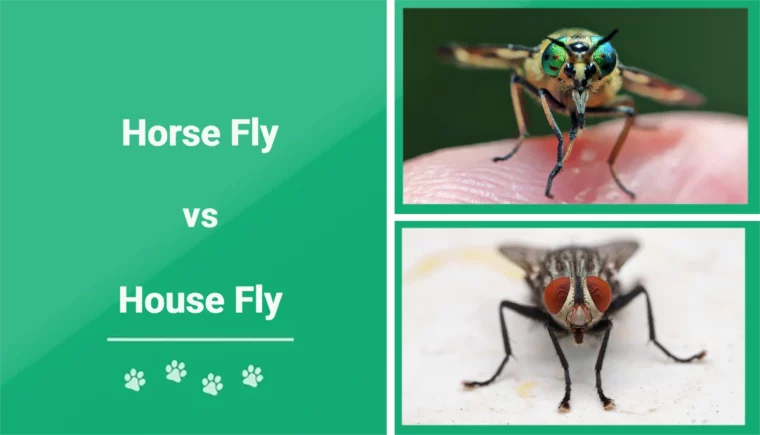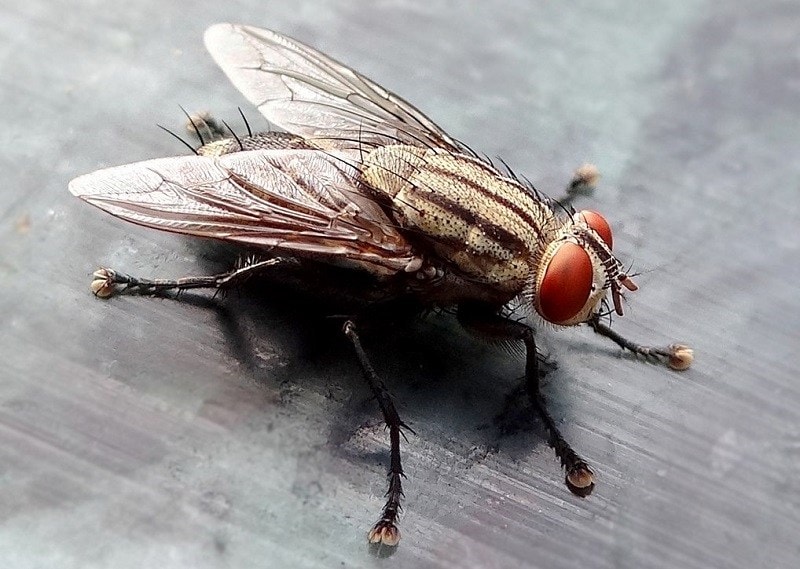
Click to Skip Ahead
Horse flies and house flies are both common insects. They look similar but are quite different, and it can help to know the difference because a house fly is nearly harmless while a horse fly can deliver a painful bite. If you live on a farm or a rural setting, you’re probably familiar with that bite, so we are going to help you recognize them from a distance. We’ll also help you learn how to spot the house fly and give you other information about them so you can be better informed.
Visual Differences

At a Glance
Horse Fly Overview

Description
A horse fly is considerably larger than a house fly. These flies can often reach 1 inch in length and are agile fliers. It’s found worldwide except in Hawaii, Greenland, Iceland, and the polar regions. It prefers direct sunlight, often avoiding shady and dark areas. It has large compound eyes with short antennae. The head has short hairs, but there are none on the body. It may have a yellow body or black with a green sheen. Some species have noisy wings, while others, including the common green horse fly, are silent. It typically feeds and nectar and other plant fluids and is an important pollinator in some parts of the world.
Breeding
Although the horse fly eats only plant fluids, most people will recognize them as biting flies. The reason these flies bite is that the females need blood to lay their eggs. She can lay up to 500 eggs, and she will deposit them on a leaf over the water. When they hatch, the larvae will fall into the water, where they can continue to develop. The larvae are carnivorous and will eat worms and arthropods. Since the female needs so much blood, these flies will relentlessly chase after their target. The females have mouths shaped like a spear, so they jab their prey to collect the blood. The males do not have the same mouthparts and do not bite.
Habitat
You will often find horse flies near water because that is where they lay their eggs. They especially like warm climates and can be formidable enemies at the beach or near ponds and swampy areas. They can also transmit serious bloodborne diseases because they can bite several people in a day. It likes to bite the legs, so you can get a bit of relief by wearing pants.

House Fly Overview

Description
The common house fly is a small insect that may have originated in ancient times around Iraq. It has since spread throughout the rest of the world, following humans, and it is one of the most commonly seen insects. It’s small in size and only reaches a length of about 6–7 millimeters and is usually grey or black. The body will be slightly hairy, and it will have a single pair of membranous wings. These flies like to land on our food and can contaminate it with their feces, causing a health concern. It can also carry diseases on its body and in its feces that it can spread around. However, house flies are important for the environment in that they break down and recycle organic matter.
Breeding
Female house flies typically lay about 500 eggs in their lifetime over several batches of 80 to 150 eggs. The fly carefully places the eggs in decaying organic material like food waste and feces. The eggs hatch as maggots within a day and will begin to feed on the organic matter. It will take 2 to 4 weeks before a maggot transforms into a pupa, during which time, it will avoid the light. This pupae state can last up to 3 weeks before the fly emerges as an adult. It usually lives about 2 to 4 weeks once it becomes an adult but can hibernate through the winter when the temperature gets below 40 degrees Fahrenheit.
Habitat
House flies are common around humans and feed off our waste. You can usually find them easily by looking in the garbage can on a hot summer day, when conditions are perfect for breeding. You will also see adult flies swarming around dog and cat feces, as they are looking for a place to lay their eggs.
Final Thoughts
Both house flies and horse flies are a nuisance to humans, but horse flies are worse. They have a painful bite and can transmit diseases. They are also relentless and can easily ruin a picnic, walk, or trip to the beach, especially if you have small children. While we could certainly do without their maggots in our garbage, house flies are relatively harmless. That said, they can also transmit disease, and house flies like to be around decaying things, so you don’t want one to land on you.
Featured Image Credit: Top – Achkin, Shutterstock | Bottom – Anand RJ, Shutterstock









